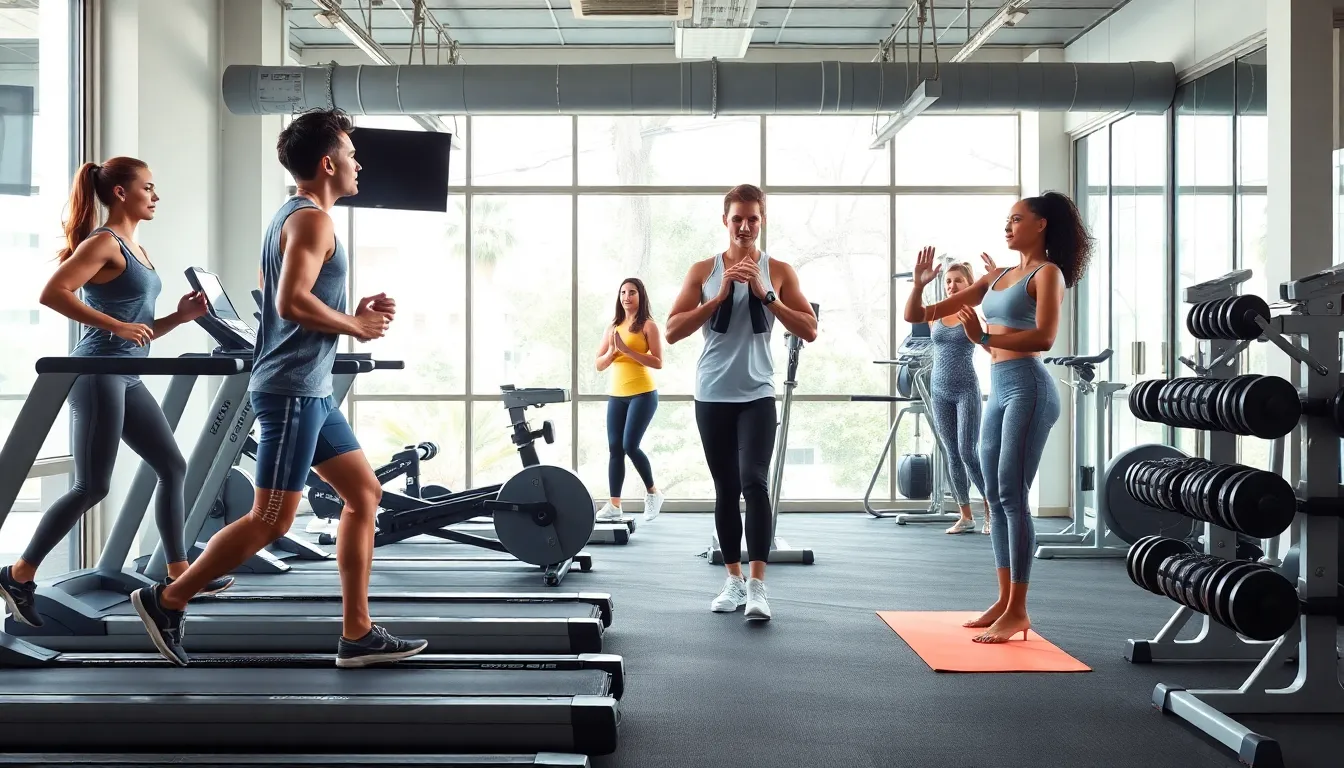In a world where the couch seems to have a gravitational pull, exercise equipment stands as a beacon of hope for those looking to break free from the clutches of Netflix. Whether it’s a treadmill that doubles as a clothes rack or weights that make great doorstops, the right gear can transform a mundane living room into a personal gym.
exercise equipment
Exercise equipment plays a crucial role in facilitating a more active lifestyle. Various types of equipment cater to different fitness goals, making it easier for individuals to find their preferred workout methods. Common pieces include dumbbells, resistance bands, and treadmills, each offering unique benefits.
Dumbbells enhance strength training by allowing targeted muscle workouts. Resistance bands improve flexibility and can assist with strength training in a space-efficient manner. Treadmills offer a reliable way to achieve cardiovascular fitness indoors, often featuring adjustable speeds to suit different fitness levels.
Moreover, modern exercise equipment often integrates technology. Many gym machines come equipped with screens for workout tracking, enabling users to measure progress. Some advanced models even sync with fitness apps to provide personalized training programs.
Affordability and accessibility matter when choosing equipment. Many cost-effective options exist, making it possible for individuals to build a home gym without a large investment. Compact designs make it easier to store equipment in small spaces, ensuring that even those with limited room can maintain an effective workout routine.
Safety features on equipment enhance user experience. Ergonomic designs help prevent strain or injury during workouts. Adjustable settings accommodate various heights and fitness levels, promoting safe usage for everyone.
Popular categories of exercise equipment include cardiovascular machines, strength training tools, and functional trainers. Cardiovascular machines improve heart health, while strength training tools build muscle. Functional trainers support mobility through versatile exercises, making it easier to incorporate a well-rounded fitness regimen.
Types of Exercise Equipment

Exercise equipment varies to meet diverse fitness needs. From machines for cardio to tools for strength, each category offers distinct benefits.
Cardiovascular Equipment
Cardiovascular equipment enhances heart health and endurance. Common choices include treadmills, elliptical trainers, and stationary bikes. Treadmills allow users to walk or run indoors, while elliptical trainers provide a low-impact alternative. Stationary bikes cater to those who prefer cycling without outdoor weather concerns. Many models come with built-in programs that track heart rates and calories burned, making exercises engaging and measurable.
Strength Training Equipment
Strength training equipment focuses on building muscle and improving bone density. Free weights such as dumbbells and kettlebells play a central role in resistance training. Benches and weight machines provide additional options for varied workouts, targeting specific muscle groups. Adjustable weight options cater to different fitness levels, allowing gradual progression. Proper form and safety features are essential when using this equipment to prevent injuries.
Flexibility and Balance Equipment
Flexibility and balance equipment promotes movement efficiency and stability. Items like yoga mats, stability balls, and resistance bands enhance stretching and core strength. Yoga mats provide a comfortable surface for floor exercises. Stability balls offer dynamic support for improving balance and posture. Resistance bands are versatile tools that aid in flexibility training, accommodating all fitness levels. Incorporating these elements into workouts contributes to a balanced and well-rounded exercise regimen.
Factors to Consider When Choosing Exercise Equipment
Choosing exercise equipment requires careful consideration of several factors to ensure a perfect fit for personal fitness goals.
Space Requirements
Space plays a critical role in equipment selection. It’s essential to measure available areas before purchasing any gear. Compact options work well for small homes, while larger items may require dedicated workout rooms. Foldable or multi-purpose equipment offers versatility and easier storage. Opting for machines that have a smaller footprint can help maximize usable space. Assessing height and width helps avoid cramped conditions during workouts.
Budget Considerations
Budget impacts the selection of exercise equipment significantly. Many affordable options exist without sacrificing quality. Setting a clear budget allows for more informed purchasing decisions, providing access to various equipment types. Used equipment offers an economical alternative, often available through classified ads or resale sites. Speaking with fitness experts about cost-effective choices can enhance value. Allocating funds for essential gear first ensures foundational training needs are met.
User Experience and Comfort
User experience directly influences workout consistency. Equipment should feel comfortable and intuitive to use. Adjustable features accommodate different body types, promoting proper form and reducing injury risk. Material quality also affects comfort during exercise sessions. Seeking equipment with ergonomic designs enhances usability. Trying equipment in stores before committing ensures it meets personal comfort standards. Prioritizing comfort can lead to improved motivation and better overall results.
Popular Brands and Models
Numerous brands offer high-quality exercise equipment to cater to different fitness needs. Below are overviews of two notable brands that stand out in the industry.
Brand A Overview
Brand A specializes in innovative fitness solutions, focusing on both durability and style. Their product range includes cardio machines, strength training equipment, and accessories. Each item emphasizes user-friendly designs, making workouts safe and effective. Customers appreciate the advanced technology integrated into their machines, such as interactive screens and fitness app compatibility. Many users report significant improvements in their fitness routines after incorporating Brand A’s equipment into their home gyms. With a commitment to quality and performance, Brand A ensures its equipment meets the demands of various fitness levels.
Brand B Overview
Brand B is well-known for its extensive selection of cost-effective exercise equipment designed for at-home workouts. Their offerings include multifunctional gym systems, free weights, and resistance bands. A strong focus on user comfort sets Brand B apart, incorporating adjustable features for optimal fit. Customers often highlight the ease of assembly and storage, making it an appealing choice for those with limited space. The brand also emphasizes community support through online resources and workout programs. By prioritizing affordability without compromising quality, Brand B has successfully attracted a diverse clientele seeking reliable fitness solutions.
Conclusion
Embracing exercise equipment can transform an ordinary living space into a dynamic workout environment. With a variety of options tailored to different fitness goals and budgets, individuals can find the perfect tools to support their health journey.
Prioritizing comfort and safety ensures a positive experience while exercising at home. As technology continues to evolve, integrating smart features into equipment enhances motivation and tracking progress.
Whether opting for compact solutions or investing in multifunctional systems, the right equipment makes staying active more achievable. Ultimately, the journey to fitness is personal and having the right tools can make all the difference.

